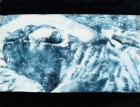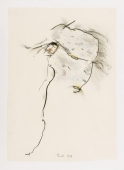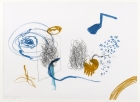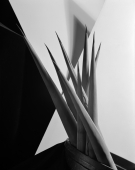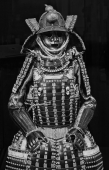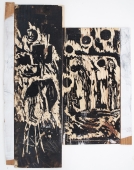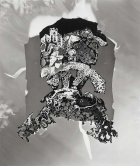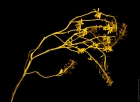
Artist | Matthew Barney (*1967)
https://www.artist-info.com/artist/Matthew-Barney
Biography
Biography
Born 1967 in San Fancisco
lives and works in New York
About the work I
About the work I
A DIFFERENT STORY OF GENDER AND GENERATION - Matthew Barney's Cremaster Cycle
Since only three parts of the five-part "Cremaster" cycle have been completed to date, closer examination of "Cremaster 1" must remain tentative. Nonetheless, a meaningful discussion of the first part is feasible on taking a look at the ten years of Matthew Barney's (b. 1967) work to date and in particular at "Cremaster 4" and "5", both already completed. Before beginning work on this cycle in 1994, Barney had already presented a personal universe that pits great mastery against discomfiting idiosyncrasy, in the single-minded pursuit of recurring aspects and elements of both form and content. A look at the early work will reveal some of the characteristic features of this artist's universe.
"I've spent my entire life working with my body ..."
THE BEGINNINGS
In the composition and elaboration of his works, their form and content, Matthew Barney has always drawn on his own body as a central means of expression. His performances do not take place with an audience but are filmed and subsequently presented in the form of videos. In conjunction with these, Barney makes objects related to the properties and situations in his performances, as well as object-like drawings. His oeuvre thus always entails performance in combination with a diversity of media and materials.
Between 1989 and 1993, Barney produced his "Drawing Restraint" series, in which he "devised a number of situations which did for drawing what the wearing of ankle weights does for jogging: increased its strenuousness. These 'facilities to defeat the facility of drawing,' as Barney called them, necessitated that the artist pounce on a trampoline, climb ramps while straining at the end of tethers, and push blocking sleds (used to develop line skills in football training) simply in order to draw." (1) An absurd performance situation indeed, but the characteristics of the action are perfectly familiar: the strain, the tension and concentration of the toiling body, the effort to overcome physical limitations, and the endurance. Athletic training, specifically body building, had become particularly entrenched in American daily life and in popular culture by the 1980s. Against this background it may not only be interpreted as a celebration of the body but, in the era of AIDS also as a transformation of sexuality into the auto-eroticism of body building.(2) As such, it has functioned as an important building block in Barney's art. When asked if he was interested in the idea of experimenting with limits, he replied, "Yeah of course, but I think I came to that because the idea was familiar to me. I've spent my entire life working with my body in the same way. It was a very natural change. It ended up being very similar with those kinds of narrative that are constructed inside the head of an athlete." (3)
In later works, the body functions even more explicitly and as a specifically athletic object. In "Mile High Threshold: Flight with the Anal Sadistic Warrior" (1991), for example, Barney, supported by a body harness and using titanium ice screws, climbs naked up the walls of a room and tries to cross the ceiling hanging upside down. This emphasis on the body and bodily action quite naturally leads into a sexual discourse that embraces lust, pain, ecstasy, and asceticism. During the performance the body orifices, especially the anus, are incorporated quite as much as the athletic body as a whole. Medical associations follow as an equally logical consequence of his actions, as shown in his use of instruments with which to examine the interior of the body (speculums, hemorrhoidal ligator) and of materials like silicone and petroleum jelly.
Characteristic of the image of the body, as expressed in the performance videos, is its permeability in both directions as well as the mutual assimilation of body and objects. In the videos, body and machine may function as an inseparably intertwined whole. The artistic objects that accompany the videos resemble gymnastic gear. The distinction between organic and inorganic is, however, most trenchantly undermined by the choice of materials used to make the objects: sucrose, tapioca, and glucose on one hand, petroleum jelly, silicone and other prosthetic materials on the other. (4)
A major catalytic role in the development of Barney's imagery is played by a series of figures of historical and mythological origins. These figures metaphorically represent an image of the body that has gradually evolved and acquired priority in Barney's vision of the world. They lend the meticulous and experimental artistic approach a narrative impulse that instantly catapults the performance art of the late sixties and early seventies into an entirely different universe. One of the earliest of these figures was Jim Otto, the famous Oakland Raiders center, 1960-1975, who has become legendary for playing as brilliantly as ever, though under great duress, with two artificial kneecaps. (5) There is also Harry Houdini, born in Budapest in 1874 as Erik Weisz and famed in the United States for his feats of extrication, to whom Barney still ascribes exemplary significance. (6) In "Drawing Restraint 7" of 1993, three satyrs signal Barney's interest in Greek mythology and its demigods, furthermore hinting at the trivial mythology of the horror film and its array of menacing hybrids between man and machine. (7)
A study of the elements that characterize Matthew Barney's worldview yields several insights. His own body lies at the core of his work; its exploitation rests on his athletic training and his aborted study of medicine. The performances are motivated by the incessant wish to conquer the natural limitations of the body and its resistance and ultimately to store, and even hold in abeyance, a potential of energy and tension. The work intimately associates body, equipment, and substances, organic and inorganic matter, human life and lifeless impedimenta; it is a phenomenon of synthesis directly addressed in the concurrent art objects as well. This basic agenda gradually leads to a multileveled narrative discourse, in which the auto-erotic concentration on the body begins to merge with a mythology of the artist's own invention.
"The pieces have become more about storytelling.
THE CREMASTER CYCLE
Barney's early work has proved to be but a prelude to the grandiose and hybrid worldview that unfolds in the "Cremaster" cycle, which - one is tempted to claim - is not only typical of the nineties but even symptomatic of an outgoing millennium. Barney conceived "Cremaster" as a drama in five acts. Only then did he begin with the implementation and production of his master plan. Each of the parts completed to date consists of a video, about an hour in length, a group of discrete objects, and a picture book. First the film is presented to the public. Barney stages the objects - large sculptures, small objects, photographs, and drawings in plastic frames - in separate installations. Their presence is patently distinct from the reality of the film.
The "Cremaster" films tell different or rather more obvious stories than do the earlier works. They have specific locations, a differentiated cast, and plots of varying intensities. The main characters (Miss Goodyear in "Cremaster 1", the Loughton Candidate in "Cremaster 4", and a couple in "Cremaster 5", the male in three embodiments - an actor of sorts, a satyr, and a knight in shining armor - played by Barney, and the female half as the Queen of Chain) may still perform feats of athletic prowess but they are now integrated in a story that is propelled by other narrative forces as well.(8) First and foremost, there is the location. It basically defines the atmosphere, formal appearance, and content of the story in keeping with Barney's worldview.
The story of "Cremaster 4", the first film to be produced, takes place on an island. Barney chose the Isle of Man, which lies like an organic body in the Irish Sea between England, Scotland, Wales, and Ireland. It is invested with two layers of legend. The name is said to come from the Celtic god Manannan. Numerous myths and legends have survived, in which demigods, satyrs, fairies, and the Isle of Man itself play a role. The second layer is of more recent origin. Since the 1960s, the island has been host to the world-famous T. T. (Tourist Trophy) Motorbike Races. The island and its repertoire of folklore provide the stage, the setting, and the central motifs for the story Barney tells. Several factors testify to the artist's indebtedness to these traditions: the treatment of the island as a body; the presence of satyrs and fairies versus manned motorbikes with their attendant soundscape; an atmosphere laden with mystery and suspense; and the luminous coloring of the pictures, recalling magnificently illuminated medieval manuscripts. The Isle of Man's medieval coat of arms, consisting of three armored legs with spurs on the heels emanating from a common center, is not only the logo of the races but has also come to identify "Cremaster 4". (9) However, the set pieces of the legends and Barney's narrative are so closely intertwined that it is no longer possible to distinguish between the artist's modification of the island's folklore and the influence of the folklore on Barney's mythology.
The film of "Cremaster 1" is not much different in this respect. The setting is a football stadium, which naturally includes the appearance of Goodyear Blimps, as the hallmark of almost every major mass sporting event in the United States.(10) Barney shot the film at the Bronco Stadium in Boise, Idaho - an appropriate choice not only because of the unusual blue of the ground cover but also because Barney grew up in Boise and played football in the stadium. The world of American football, epitomized by the Boise Stadium, acts as the stage and the central motif of the narrative in "Cremaster 1". This is reflected in the action that is concentrated on the playing field under the watchful company of two blimps overhead. It includes the cheerleaders, or rather chorus girls, and stewardesses in formation, a soundscape of popular music accompanying the chorus girls, the roar and drone of the blimps, the atmosphere of excitement and anticipation that typically precedes a major sporting event, and the slightly saccharine color scheme resembling a thirties' musical. The Goodyear logo, Mercury's winged sandal, figures as an omnipresent device in "Cremaster 1".
While the location and setting in the first part of the "Cremaster" cycle communicate the gaiety of anticipation as a prelude to the coming "game," the last part contains elements that characterize it as a finale. The setting of "Cremaster 5" is a bathhouse, significantly the Gellért Thermal Baths in Budapest, Houdini's birthplace. The choice of Budapest added two other arenas to the action in "Cremaster 5": the opera house and the chain bridge. The Gellért Baths and the opera house in Budapest bear witness to central Europe's rich cultural past, which lives on today in literature, music, and films. Barney reanimates these venerable, historical sites with all the grandeur and pomp of a by-gone age. His theatrical figures conjure a mood of nostalgic decline, heightened to the point of melodrama by romanticized opera music.
"Cremaster 3" will be filmed on a Canadian ice field; and "Cremaster 2" in the Chrysler Building in New York. Although these two parts do not yet exist, there is no doubt that the five locations - playing field (football stadium), tower (Chrysler Building), ice field, island (Isle of Man), and bath house/bridge/opera house (Budapest) - provide eloquent scenarios for Barney's ambitious dramaturgy. The locations have been chosen with remarkable precision. They lend themselves to stylization as topographic metaphors and yet they each potentially contain a wealth of symbolic, contemporary, and historical references. Barney exploits these two sets of values with compelling mastery.
The artist's focus on the athletic body as the point of departure in his early works has been pursued to explosive extremes through the introduction of complex staging in the "Cremaster" cycle. It is exciting to observe how this has influenced the evolving nature and direction of Barney's imagery. In the following, "Cremaster 1" will be examined more closely with occasional comments on the fourth and fifth parts of the cycle.
CREMASTER 1: THE HISTORY OF PART ONE
The story of "Cremaster 1" takes place on two levels: on the football field below and in two blimps floating above. It is night, the stadium is floodlit, the bleachers are empty. On the blue ground covering (known as Astroturf), chorus girls - eighty of them - glide over the surface in constantly changing formations. They are wearing bell-shaped, orange-and-white costumes and stiff white headgear; their faces are frozen in bright, radiant smiles. The string orchestra accompanying the scene could be playing melodies for a musical. The moment the scene cuts to the interior of the blimps above, the droning of the engines drowns out all other sound. Four stewardesses, wearing austere gray uniforms, are sitting in the two blimps. They have nothing to do; they act utterly blasé and bored though they obviously can't wait to land. They smoke or look out of the portholes at the events below. There is a long white table in the middle with a beautiful centerpiece surrounded by mountains of grapes, red in one blimp, green in the other. The stewardesses do not notice the platinum blonde protagonist of "Cremaster 1", Miss Goodyear, sinuously slithering around the huge funnel-shaped leg of the table. She is wearing elegant, light silk lingerie and high-heeled plastic sandals. In a slow, laborious and ingenious ritual, she drills a hole with a bobby pin through the tabletop from underneath, through which she keeps filching single grapes. After they have mysteriously journeyed through her body, she lays them out on the floor in a number of different patterns. Sometimes the patterns clearly represent female organs of reproduction: ovaries, Fallopian tubes, and uterus. As soon as a pattern has emerged, the scene cuts to the chorus girls executing dance steps that conform to Miss Goodyear's pattern. The film is, in fact, structurally based on the principle of one form leading to another: "none of them stand for themselves or for an immutable meaning - no ball, no capsule, no circle, no keyhole, no funnel, no diagram of genitals."(11) Thus, like the Fates, Miss Goodyear directs the choreography of the dancers with her sophisticated, acrobatic and secretly conducted ritual. Because of her activity, the girls can never stop moving, the music can never come to a halt but keeps repeating itself, the blimps can never land, and the film ultimately has neither a beginning nor an end. If the blimps could land, it would mean two oval (ovary shaped) aircraft touching down on a playing field, whose goal posts and stadium building could be read as ciphers of male genitals. Miss Goodyear systematically prevents this landing and coupling in favor of a permanent self-generation; the indeterminacy and tension of the entire scenario is thus sustained, never to be resolved. The cheerful, bright mood of anticipation shifts in the course of the film to a mechanical, impersonal and tense attitude of suspended animation.
The large sculpture for "Cremaster 1" is titled "Goodyear Field". It consists of a blue surface and a multipartite white structure, the whole measuring approximately 23 x 27 feet. The intense blue of the ground is artistically trimmed with a white ruffle and a broad, white border all around. The multipartite structure stands - one might also say, experimentally, that it is floating or suspended - in the middle. The main component is a long table, supported by one centrally placed, funnel-shaped leg. Actually, there are two tabletops, superimposed but spread apart like a pair of scissors. The object with two feelers sitting on top is obviously a stylized enlargement of ovaries, given the knowledge of the film. Innumerable little white balls are piled up around this object. On the floor, a circle of thirteen longish white forms, resembling whitecaps or Hermes' cap, is laid out, following the contours of the scissors-like table. Spilling out of each one is a layer of tiny little white pellets. A heavy cloth is draped over the table, but skillfully pulled up and puckered on one side to allow viewers to see thirteen elegant sandals arranged in a second, smaller circle underneath. A twisted length of white ribbon coming from the toe of each sandal ends in a pearl. One last element only becomes apparent on closer examination: a small, sparkling metal instrument placed on the table in the exact center above the smaller circle of sandals. It is a speculum inserted from above into a hole in the table and coming out underneath as a phial that looks like a large glass drop. A second speculum is inserted in tandem on the other tabletop but this one has not formed a drop.
The sculpture as a whole conveys extreme refinement, affectation, and precision. It is detailed with a goldsmith's perfection and has the appearance of theatrical staging translated into a visual piece of work. The materials (selflubricating plastic, prosthetic plastic, petroleum jelly, silicone, pearlescent vinyl, tapioca, polyester, and costume pearls) underscore this overall impression. In addition, their intensely haptic aura only makes them seem even more fragile and vulnerable.
Having seen both the sculpture and the film of "Cremaster 1", one cannot help comparing them. Several of the elements in the film reappear in the sculpture: the Astroturf on the football field, the tables in the blimps, the grapes, the chorus girls' headgear, Miss Goodyear's shoes. However, a comparison between the film and the sculpture is more fruitful in terms of the difference between the two media, each governed by distinct laws: the extension in time intrinsic to a film narrative as opposed to the condensed concurrence of a sculpture(12) The sculpture is basically devoted to Miss Goodyear and her immediate surroundings, i.e. to the protagonist whose actions define the events in the film, just as the athletic performance of Barney's body completely determined the earlier works. The division of the "sculptural event" into an upper, white part and a lower, blue one with two white circles (formed by the headgear and the shoes) ties in with the narrative spread of the film, but is here abbreviated into a pictorial, plastic formula. Miss Goodyear's laborious "drawing" of female genital organs, against all physical odds, obviously lies at the heart of the message conveyed by "Cremaster 1". In the film we see the consequences of the act of "drawing," whereas the sculpture appears as a plastic monument to that ritual.
One motif has always been conspicuous in Barney's oeuvre regardless of medium and it is deployed in the "Cremaster" cycle with particular persistence. It is the motif of the orifice or the hole, and the related gestures of opening and closing, disclosure and concealment, protrusion and penetration. The motif may take the shape of a porthole, a tunnel, a mouth, an anus, or a speculum. Since 1988, Barney has used an abstracted form that stands, among other things, as a symbol for filling or stopping a hole(13) It has figured in the heraldry of all three parts of the "Cremaster" cycle completed so far. The motif allows the exchange between inside and outside, top and bottom, body and surroundings. "The holes are there because these pieces are constructed to create balance between different zones that are in conflict. One zone might build up too much energy and a release valve is necessary. I look at those holes as valves."(14) This motif sets the "balls" rolling in the course of the film "Cremaster 1"; it also plays a constituent role in the sculpture in the form of the two speculums and the demonstrative gesture of disclosure by raising the tablecloth.(15)
A DIFFERENT STORY OF GENDER AND GENERATION (16)
Corresponding study of the films "Cremaster 4" and "5" reveals that the wondrous stories they tell orbit around similar issues of gender and generation. Every story - as we know - plays in its own specifically designed and staged universe, and every story elaborates on gender and generation from a different point of view as defined by the main characters. In "Cremaster 4", the protagonist, the Loughton Candidate, played by Matthew Barney, is a male, like all the members of the cast with the exception of four fairies, who are not female but rather androgynous. In "Cremaster 5" the leads are a female and a male: the Queen of Chain, played by Ursula Andress, and Matthew Barney as an actor, a satyr, and a knight in shining armor. All visible signs of gender have been de-formed into genderless body parts among the males in the cast. In all three stories, tension is generated by the attempts of the protagonists to resolve or break down the rigidity of an existing conflict.(17) The stratified complexity of the dramaturgy and the elaborate staging in all of the films are essentially the embodied tension between the sexes, and the frustrated resolution or impossibility of union signifies thwarted reproduction or conception. The motif of the opening, as described above, acquires a key, metaphorical significance. Extreme efforts are made to resolve the tension; the frustration, or rather, the failure to achieve a resolution becomes increasingly dramatic from film to film and ultimately acquires tragic stature.(18) Most importantly, however, the drama of these proceedings is utterly devoid of any emotions or interpersonal feelings as if to demonstrate the mechanistic functioning of a biological system; one could call it the "dramatization of the reproductive system."(19) It gradually becomes obvious that there is no clear-cut answer to the right or successful way of resolving the tension that has been building up. The main characters most frequently attempt to find a way out - and perhaps the only one that appears likely to succeed -through self-reference beyond gender specificity.(20) Borderline experiences, renunciation, and impotence characterize the actions of the protagonists; slowly the stories become impregnated with a sense of isolation and emptiness.
"Cremaster" is the title of a five-part cycle. "Cremaster" sounds like the name of a hero, like Odysseus or Parsifal or The Man Without Qualities. But Cremaster is also the medical term for the muscle that regulates the temperature of the testes and ensures the potency of the sperm. In cold temperatures, the Cremaster muscle draws the testes close to the body; in warm weather, the muscle relaxes. At first sight, the title might be interpreted as a male fantasy, but it aims at the narrative core of gender and generation, manifested by Matthew Barney as a system in a state of unresolvable suspension, although it is theoretically intended for consummation.
It is symptomatic that, in the nineties of our century or, rather, at the end of a millennium marked by bloody ethnic conflicts on one hand and the conquest of cyberspace on the other, a preoccupation with the future not only of our own bodies but of humankind itself has once again become a vital issue. Matthew Barney is a child of his, of our time. But above all Barney is a child of America, where AIDS and its consequences have led to the puritan country's typical duality of excess and self-restraint, which initially influenced the sexual behavior of the individual and subsequently the entire fabric of everyday culture. The narrative of gender and generation as a system that can never be resolved and will never find a harmonious balance but is condemned to remain forever suspended in a state of selfreferentiality - this narrative is not Matthew Barney's invention. Literature and art have addressed the issue in many different forms and from as many viewpoints over the centuries.(21) The consistency with which Barney presents and generalizes self-referentiality as an artistic phenomenon leads to unheard-of and unseen images and visions.
EPILOGUE
Let us take another look, from this vantage point, at Goodyear Field, the sculpture accompanying "Cremaster 1". As we have seen, it is not a relic of the film performance. It communicates its own "plastic" reality and makes an impact independently of the film. Certain aspects of Barney's "other narrative" of gender and generation are condensed in these sculptural visions. We have called "Goodyear Field" a self-referential and auto-erotic monument to Miss Goodyear's drawing ritual in the film. It is a sculptural demonstration of the fertile, exuberant willingness of female organs of reproduction to be united and at the same time the impossibility of their union. It is tempting to ask what aspects of Barney's narrative have been captured in the other large sculptures in the "Cremaster" cycle and what insights they would yield in combination.
One last remark must be added: The "Cremaster" cycle with all of its components is extraordinarily stimulating; it is a cornucopia of sensual and visual experiences beyond all other experience. Extravagantly voluptuous appearances in combination with rigorous precision and conscious calculation in the organization of the whole and its parts succeed in eliciting feelings of ecstasy and rapture. Barney has created an artistic universe of vibrant tension, of fantastic richness, of touching beauty - wonderful and painful at once.
Text by Theodora Vischer, Museum für Gegenwartskunst, Basel, 1998
Translation from german: Catberine Schelbert
(1) Keith Seward, "Matthew Barney and Beyon" in: Parkett 45/1995, p. 58.
(2) I thank Jean-Christophe Ammann for pointing out the video installation "Les larmes d'acier" (1987) by Marie-Jo Lafontaine, which adresses the relation between transformed sexuality and body building.
(3) Barney in: "Interview par Jérôme Sans: Matthew Barney. Modem Heroes" in: artpress 20411995, p. 28.
(4) On the choice of materials, see Norman Bryson, "Matthew Barney's Gonadotrophic Cavalcade" in: Parkett 45/1995, pp.31 f
(5) Explicitly in such works as "The Jim Otto Suite", 1991 or OTTOshaft, 1992.
(6) E.g. in the film "Cremaster 5" and in "Cremaster 2", now in production. Cf. Barney, note 3, p. 28.
(7) As exemplified in James Graham Ballard's novel 2Crash", 1973 and its film version by David Cronenberg.
(8) In response to the comment that "Cremaster" also experiments with the body, Barney replies, "For me it's more about an abstract narrative - in this case an attempt to define these different zones that are assigned to some kind of physiological zone but are actually more about psychological space. I think that's what I'm focused more on now, storytelling, using the same idea of taking an organism - an island or a stadium or a gallery or a parking garage - and fracturing it up into these fields in conflict and trying to balance them which is always impossible, thank God!" (see note 3, pp. 26 £) and: "It's like a game of add-on. The pieces have become more about storytelling: 'character zones' are created for a given project, and as they reach their limit of development (or lack of it), the remaining, unarticulated aspects of that zone become the outline for the next set of characters." (see note 16, p. 69).
(9) See Internet url: http://www.isle-of-man.com
(10) See Internet url: http://www.goodyear.com
(11) Alexander Horwath, "Le crémystère. Einige Bilder zu Matthew Barney, Cremaster 1 und Kino, "in the insert for the book "Cremaster 1" published on the occasion of the exhibition at the Wiener Kunsthalle, Vienna, 1997.
(12) Asked if, to him, the works created in connection with his films were relics, Barney replied: "No, I consider them secondary forms. For me a project isn't really complete until it goes through a primary, secondary, and tertiary state. In some cases it might be a book which becomes the third state of the project, or a body of photography which slows down the narrative and crystallizes certain aspects of the conflict. The objects function in the same way." (see note 3, p. 30)
(13) "That came out of drawing, out of this notion of an opening into an organism and its self-imposed closure, whether it be a blindfold, a titanium screw, or whatever. The piece "Field Dressing", where a chunk of Vaseline was frozen into that field form and then used to fill and close off the various orifices in the body, also relates to that idea." Barney, see note 16, p. 69. Cf. also Jerry Seltz, "Das dritte Geschlecht. Anmerkungen zu Matthew Barneys "Cremaster 4" in: Matthew Barney, Tony Oursler, Jeff Wall. Sammlung Götz (Munich), Hamburg, 1996, p. 12.
(14) Barney, see note 3, p. 32.
(15) In addition to the large sculpture "Goodyear Field", owned by the Emanuel Hoffmann Foundation, and the film shown on two monitors in a neighboring room, the exhibition "Cremaster 1" in Basel showed several other objects that Barney included in the installation. While, the twelve drawings in their thick white frames follow the same procedure as the sculpture by reproducing the "patterns" that Miss Goodyear draws in the film, the narrative dimension of the film is captured not only in six display cases, but even more so in six flags and, finally, in a Goodyear frieze that runs the entire length of the walls.
(16) The title is inspired by Thyrza Nichols Goodeve's introduction to her interview with Matthew Barney after the completion of "Cremaster 4". The passage reads: "And familiar objects appear only to be reborn, reanimated within an elaborate esthetic/genetic cosmology that, yes, attempts to tell stories of gender and generation differently." In: "Travels in Hypertrophia. T. N. Goodeve talks with Matthew Barney" in: Artforum, May 1995, p. 67.
(17) "Gender has been at least one of the foundations for building this narrative. I'm less interested in the external debate about gender, which I don't think my work is about. It's more about the endless possibilities this organism can take on, the fact that it can occupy a field that is designated as feminine or masculine or androgynous, but I'm not more interested in one than another." Barney, see note 3, p. 28.
(18) In a certain way they all end up being tragic. In the way that the narratives a c never really allowed to resolve themselves in any way." Barney, see note 3, p. 30.
(19) Roberta Smith, 'From a Fantasy Film, Luxury Transformed" in: New York Times, November 14, 1997, B 35.
(20) In an unpublished essay "Matthew Barney als Anal Sadistic Warrior - Gedanken zu Cremaster 5,"Jean-Christophe Ammann discusses self-reference as part of a vision in which Matthew Barney turns the world anal side up.
(21) For example, the phenomenon of the bachelor machine, as discussed and illustrated in Michel Carrouges's book "Les Machines célibataires" (Paris, 1954) and later by Harald Szeemann in his legendary exhibition "Junggesellenmaschinen / Les Machines Célibataires", 1975; or science fiction and horror films, most recently in David Cronenberg's productions.
About the work II
About the work II
BARNEY IN THE MOTION PICTURE
SYNTHESES IN THE IN-BETWTEN
Anyone who brings forth the scandalous enigma of a title like "Cremaster" not only sends out the challenge to solve and promote it as a guideline for further interpretation, but also to join in the game of puzzling and punning in any number of languages, jargons, and discourses. The German language with its delight in endless run-on compounds could not be more suited to drowning Matthew Barney's art in a deluge of indecipherable deciphering description. As tempting - and economical - as it may be to exploit the German language's passion for synthesizing to produce a succinct formula for the artist's engagingly horrendous exhibitionism (hermaphroditesatyrcentaurmachinehybridhumanprothesisandrogynousmutantslimybodysnatcher) or to boaconstrict his artistic praxis (extricatorbodybuildingperformancesculptureinstailationvideofilmauthorproducer), this essay on Matthew Barney as a filmmaker (1) is meant to address English-language readers as well, for which reason an effort will be made, in the following, to resist such temptation wherever and whenever possible.
Instead, a first thesis will explain why the path taken by this multi-artist has inevitably led to the cinema. Barney, the appropriator, transformer, and also the virtualizer of his own body, is an in-between synthesizer - as in motion pictures. The world, real or imaginary, is their stage as well; its stuff is transformed for the public between screen and projector - straight across locations, times and perspectives, omnipresent in and between the moving pictures.
Barney's basic agenda of overcoming the physical limitations of the body against all odds is thus eminently cinematic in nature. The medium of the cinema happily looks back on more than a century of history, and in terms of subject matter, motif, the history of the media and institutions, it is actually a semi-natural device of abandoned deregulation. As such, it is the most essential precursor of cyberspace, with which Barney has a greater rapport in one respect than with the grand heartstring-pulling machine: the feature film. "Synthesis" in motion pictures implies empathetic, all-pervasive involvement, but Barney remains inert, immune, and somewhere in-between: James Bond still has to wear a frogman's rubber suit over his tuxedo but amphibian Matthew Bondage manages to remain the perfectly impeccable tap-dance dandy on his underwater hike in "Cremaster 4" - even in the metabolic Vaseline caves on the Isle of Man, out of which he emerges as if out of the calyx of a carnivorous plant.
SYNTHESIS WTIHOUT ANALYSIS: POLYMERS AS METAPHORS
Given Barney's interest in the ooze of fife with its highly complex DNA formations on one hand, and in Vaseline, silicone, and the New Materials for padding and prostheses with their long hydrocarbon chains on the other, the organicistic artificial worlds of the former medical student make contact in the field of organic chemistry. And the suspense that body secretions - suspensions one and all, from a chemical point of view - entail for Barney would also speak for a corresponding progenitor of discourse if his syntheses did not so unequivocally elude precocious analysis as the be-all and end-all of chemical methodology. For, no matter how pieced together Barney's universe is, his heterogeneous elements are grafted to the rampant connective tissue of his art-body into pure synthetics; foreign bodies become perfectly absorbed implants. Medical synechia, adhesion as a principle of design, eludes the analytical scalpel,(2) just as alchemist affinities the design of their molecular valences.
SYNCRETISM AS MANNERIST MANIA
Michael Onfray (3) has described how much Barney's hybrid bizarrerie feeds on Mannerism and "Cremaster 5" has since driven the point home with a cornucopia of illustrative material in the form of oblique conceits, rampant Byzanti-Asianisms, darkly skewed syncretisms from Hellenistic mysteries, high Renaissance emblematics, New Age hermetics, and postmodern theories of bodies and media. Self-referential it is, but the capacitator art of transformer Barney is also always a reconversion of converted figures, agencies and epochs, all of which are absorbed in the peri-staltic system of the great digestion machine USA. America, the melting pot, the multi- and transcultural nation between east and west coast, Ellis Island and Silicon Valley, ghetto and campus, Mayflower and Star Wars, has always managed to come up with liason officers, capable of reducing the worlds beyond Decency and New Frontiers to a tranquilizing "according to..." formula: Hollywood, Disney, "Reader's Digest - and Playboy". Such canon-producing agencies (4) with their aesthetic amalgam of elitist and trivial forms have also spawned that mix of old and new myths and genres between Western, Fantasy and Science Fiction so typical of America's understanding of its (hi)story.
In view of this collective process of appropriation, it is as senseless as it is unnecessary to attempt to carve clear lines of influence. The fact that Barney's lush imagination lolls primarily in the inexhaustible repertoire of feature film imagery is as self-evident as are his implicit commentaries on the motion picture,(5) which have precious little to do with the currently pandemic, modishly aenemic (meta-)references to films. Naturally the object in "Cremaster 1" is also an offspring of the erect-testicles-monster in Topor's cartoon "La planète sauvage" or the slimy monstrosity in "Alien", now in its fourth sequel. And quite as naturally the mucous ice grotto with its intestinal stalagmites in "Cremaster 4" has several side entrances in Boorman's "Excalibur" as well as in "The Fantastic Voyage, The Thing, The Fly, Invasion of the Body Snatcbers", and all of their remakes.
TRESPASSING BETWEEN SCENES, GENRES AND THRESHOLDS
Among the art-conscious culture vultures of the early seventies (the generation of Barney's parents, recently subjected to cool analysis in Ang Lee's film "The Icestorm"), it was considered hip to regale party guests with home movies of Linda Lovelace's serial, laryngeal acrobatics. The next generation, which grew up with the video recorder (and Daddy's dirty movies), is thoroughly drilled in scandal-free assimilation of explicit genres: their serial dramaturgy has long since emancipated itself from the excuses of plot and double-standard didaxis, as has their iconography from ennobling hobnobbing with art.(6) The compulsion to reveal all has long since given way to narrative frivolity, according to a curiously cyclical formula that has little in common with the script recipes cooked up in Hollywood with its everlasting intertextual propensity for sequels and remakes. But it makes an unmistakable recovery in the circular dramaturgy and spiraling motifs of the Cremaster cycle (and its separate parts). Conversely, Barney flirts unabashedly with the fast-fading scandalon of dragging the dirt out of dingy corners and catapulting it into the international art scene. In the age of AIDS, consensual models, and multimedia, films that flaunt all matter of splatter, sleeze and porn have become value-free slots in the channel-switching between discourses, scenes and sectors.(7) Bodily juices there excreted en masse flow like water off a duck across Barney's teflon surfaces, which in turn excrete only synthetics. Barney the amphibian and Barney the "Artangel" - as he calls his film production company - are reconciled aspects of a prismatic being. The anthropology of the cybernetic age may relegate "wetware," i.e. humankind, to the space between hard- and software but, nonetheless, there is still room for our brave old world in the thermal, vertical control system of testicle-muscular poetics.
SYNTHESIS WITHOUT DIALECTICS: PROTHESES INSTEAD OF ANTITHESES
On the surface of discourse, Descartes' concept of the homme machine put an unpoetic end to the medieval worldview of the Analogia Entis, the hierarchical mirror-image system of material and spiritual existence, which held that human beings were the central link in a long chain of being between mortal beast and immortal angel. Transmitted by and submerged in religion, esotericism, and popular belief, this image lives on in Shakespeare, seen by Romanticism as the demiurge of possible worlds, - and in Matthew Barney.
The romantic poet-theoretician Samuel T. Coleridge lauded Shakespeare's protean faculties, the ability to retreat behind multitudes of material like a quick-change artist. He goes so far as to claim that Shakespeare's person was entirely absorbed by transformation as a "negative capability." Virtually no photographs of Matthew Barney as a person have been published - the historical subject has been entirely assimilated into the many masks of his art, a "negative" pose' that is also devoid of Hegelian Aufhebung (suspension). The poetic principle underlying the hang-flying artist's art is, in fact, much closer to Coleridge's famous formula for poetry's greatest strength, i.e. the "suspension of disbelief" that has always kept audiences of fairy tales or Hollywood thrillers happily holding their emotional and rational breaths in delicious suspense.
CREMASTER 4: MIDDLE AGE BETWEEN SHAKESPEARE AND PARSIFAL
Shakespeare, the Elizabethan, himself the link between the Middle Ages and Modernism, is the main source of Hollywood's stock-in-trade, ahistorical, romanticist image of the Middle Ages. And the Shakespeare film is naturally a communicated medieval must in the middle age of "Cremaster 4":viz Max Reinhardt and William Dieterle's "Midsummer Night's Dream" (1935) with its revues of wafting faeries, slimy gnomes, and long-eared mutants, along with the botanical figure of Oberon and the omnipresent Puck, roaming through earth and air, in the shape of child dancer Mickey Rooney's hermaphroditic body.(9) The druidic androgynous witches from Orson Welles' "Macbeth" (1947) also celebrate a comeback, as stark naked neuters with Mickey Mouse ears. Where Welles's weird sisters engage in syncretistic voodoo sorcery in order to hoist Macbeth on to the Scottish Royalty's Stone of Scone, Barney's weirdo faeries (10) affix taps to the Loughton Candidate's feet with needles so that the oedipal quest for a paternal universe may begin as soon as he has danced across the pier and plopped into the water.
But Hollywood's other source of medieval imagery also bubbles ebulliently through Barney's Isle-of-Man epic: "Cremaster 4" addresses the Anglo-Saxon legend of origins, the Arthurian saga. Prior to literature but even more so in its convoluted history of international reception, the "matière de Bretagne" is a powerful syncretism of Celtic substrata, medieval genealogy, Renaissance polyhistory, and "gesamtkunst(hand)werk"-like recreations of Wagner and the Pre-Raphaelites. How can anyone then be surprised to find Barney as perce-val, "he who pierces the valley," dispatching himself in search of the Holy Grail of his own identity? After a vertical journey of mystical timing, the Loughton Candidate arrives at the same tournament grounds and the two sidecar knights with wounds in their sides (11) meet in the wake of their contrarotating quest around the Isle of Man. It goes without saying that the world of King Arthur "according to" Hollywood's film of knighthood (12) leaves a spurred trail behind.
THE FUSION OF CIRCLE AND LINE
Unlike "Cremaster" 1 and 5, part 4 is a story of initiation - to dodge the term Entwicklungsroman (novel of development) - that tells a linear tale. But once again, the handling of the plot and the montage is only linear enough to prevent misinterpreting the omnipresence of the faeries as a leap in time.
Nevertheless, the more familiar one becomes with the three completed "Cremasters", the more exciting it is to find out when which protagonist is going to start oozing, when and where which hole is going to open up, and when which artificial organ will end up dangling from which suspensor. Apart from these suspenseful questions, the exposition and plot points in Barney's dramaturgy are suspended in a manner completely different from that of mainstream Hollywood productions. The dramaturgy responds to the space, evolving around and into loaded situations: Barney calls his highly connotative arenas "character zones." He plucks his stories out of the historically and culturally charged physiognomy of his locations, spinning them out with his own materials and weaving them inseparably into a more or less existing genre pattern. This resembles the approach Stanley Kubrick has taken over and over again since 1953 in his spare but epochal oeuvre with a flair for slow-paced ritual and Flaubertian impassibilité. In Kubrick, Barney finds an exemplary, mythomanic syncretist of subject matter and genre, notorious for inclining towards absolute control and pedantically meticulous staging, which dovetails with his agenda since he is also his own producer.
BARNEY AND KUBRICK: RISE AND REINCARNATION OUT OF THE SPIRIT OF THE CINEMATIC APPARATUS
Kubrick's scripts have often struck cognoscenti as unfilmably elitist or trivial - or both: viz the adaptations for the screen of Arthur C. Clarke's 2001: A Space Odyssey (1968) and Stephen King's The Shining (1980), though they have contributed paradigmatically to ennobling the genres of sci-fi and horror pics, and have profoundly influenced Barney's work. The anticipation of cyberspace in both films is disturbingly prophetic. Their rudimentary plots certainly do not compare favorably with the pithy formula of a "damn good story" nor with Goethe's definition of the novella as "a self-evented, unprecedented datum" so often belabored by story doctors even for gripping film plots. Instead they revolve around the fascination of unprecedented spaces, characters, or situations. They are stories of creation and transformation born of a universal intelligence questing for a body. 2001 does not go all the way back to the emergence of life out of the primal ooze of Pangaea but at least we see our shaggy progenitors merging with us, upon escaping the status naturalis through the invention of the tool. (13) The latter leads via the definitive shedding of animality - negatively embodied in the robotic intelligence of the omnipresent supercomputer HAL, consisting only of vision, voice, and brain - to the rebirth of the astronaut as a spaceship embryo with wide-open eyes. Having fallen into the galactic soup, the old homo technicus rises out of the spiral nebula of the milky way as a star child in the new world egg.
No cosmic transfiguration, but death and damnation when a burnt-out writer is visited by the evil genius loci of a snowed-in luxury hotel is the theme of The Shining, (14) but so is the breaking of the curse through the telepathic gift of the clear-sighted boy and his mother. Characteristic o Kubrick's style (and after him, Barney's) is the inseparable juxtaposition and coexistence of old and new myths: iconographically and as a narrative motif, antique mythology in the guise of Daedalus, the Minotaur, and Theseus is quite as well represented as the modernism of the psycho thriller. Even the late medieval "Mme World," seductive in front and rotting in back, makes her dramatic appearance.
It takes but a fleeting glance at prints of 2001: A Space Odyssey to realize how much concrete inspiration Barney may have culled from this film, primarily for "Cremaster 1": soft rooms covered with white plastic padding and sluices through which hostesses serve artificial food, picnics in synthetic skin, landing fields flooded in cold light and mysteriously marked for the hovering advent of cosmic visitors, copulating spacecraft that look like SM dildos with their Mickey-Mouse-ear antennae and jet ani, and the umbilical cables of astronauts severed by clawing robots.
But Kubrick's example is not exhausted in mere motival affinities. His films always reveal an undercurrent of reflection on projection and retrojection in the cinema, on those processes that swirl around in the darkness of the movie house in the physical and imaginary triangle between projector, screen, and spectator. They inquire into the substrata of reality entailed in the camera's gaze, the way in which it dominates the feature film's claim to the circularity of see(n)subject and see(n)object, and also into the supposed corporeality of screen phenomena with the odd simultaneity of their presence and absence between on screen and off.
In literal reflection thereon, Kubrick's plots toy with splitting, duplication, and symmetry. His cinematographic style is characterized by the geometry and articulation of the mirror. Frontality and pictorially parallel staging dominate the composition. Front and back are exchanged in the serial leap of the camera over the exact axis of the mirror, which happens, for example, to the gaze of subject and object through the notoriously cold stare of Kubrick's protagonists just above the eye of the lens. In addition, there is the evocation of the seeing instance, be it through explicitly systematic, gliding exposure of verticals and horizontals, often by strategically placed repoussoir figures, combined with sophisticated travelling and almost weightless crane dollying (15) or, conversely, through the "de-automating" effect of a sudden switch to hand-held cameras or helicopter shots, or to exquisite, enraptured, racing over-all views from above or below.
These select modalities of composition surface in all three "Cremasters" not merely as elements but as actual principles of style: the frontal Kubrick stare of the cool Goodyear hostesses, the strictly symmetrical, mirror-image choreography for the camera and the chorus girls, which can also be eyeballed from underneath the glass plate, the horizontally sectioned exposition of the Isle of Man as well as the vertical orientation of the pier through which figures break and plunge are all as textbook Kubrickian as is his rendition of the contrarotating motorbike races. Barney's video etudes are thus moving picture apparatuses that can be expanded and varied almost ad libitum through those of monitor, sculpture, and installation. In "Cremaster 5", shots of a classicist proscenium stage seen from above and below are conflated to the point of indistinguishability as Renaissance diva Barney in a slit costume scrambles around the stage, rappelling down and clambering up the artificial ivy.(16) This vertical and - literally - marginal action is observed by the Queen of Chain, lording it over the empty pit in the ideally positioned, single-point perspective of the royal box.
CREMASTER 1: SYMBOLICA AND DIABOLICA
Kubrick's psychotic over-all agenda, "gaze and domination," has now become explicit as opposed to its subrosa appearance as "negative capability" on the blue Astroturf of "Cremaster 1". There, Barney's corps de ballet does not meet up with grotesquely padded football machos, but only with their esprit de corps embodied in the empty Bronce, Stadium. Nor do the game rules of football prevail but rather the dictates of choreography. Instead of joining the cast this time, Barney appears "only" in the ultimate mask of the invisible arranger of the mass ornament, additionally using the omnipresent Miss Goodyear as a cover. Out of her cornucopia-funnelled cothurni,(17) she dribbles undigested grapes on to the playing field as a lot oracle or carpet bomber. Crude 3D-animation shapes these into mysterious patterns, which are then traced into a wishbone or a vagina by the chorus line of Goodyear Girls.
It is almost as if Busby Berkeley had been resurrected: the man whose magisterial discipline transported the goldbrick aura of vaudeville glitz with its straps, full-fashioned hose, and flesh-colored body stockings into the Hollywood films of the thirties. Where would Kubrick and Barney be without Berkeley's trademark, strictly mirror-image symmetry and his use of match cuts(18) to "explain" his round, often botanical human ornaments? Not only that: body-molder Berkeley was to become the pioneer of the crane dolly, being "forced" to mount his camera on a crane as the only means of achieving the kaleidoscopic verticality he envisioned for his choreography. Since the studio ceilings were not high enough for the top shot re-vue that he required, Berkeley simply ordered his crews to break through the roof, ultimately blazing a trail of holes through the tops of Hollywood's studios. (19)
Barney has gone even further. He moves verticality into outer space by showing a satellite view of the Isle of Man in "Cremaster 4". Today such verticalization can no longer be equated with hackneyed metaphorical treatment of domination. And even less so in Barney's work, where the correspondences between above and below are too vague, the analogies too mysterious, and the arenas deserted. Barney's forte is not the totalitarian nailing down of meaning but rather playing an aleatory game with semantics. Like Miss Goodyear, he is not only an - etymologically speaking -joiner of sym-bols but also a cheerfully dia-bolical conflater. Scholarly contamination of images and satirical nonsense, found fractals of reality and their insane de(re)formation peacefully coexist in cheerful serniotician Barney's possible worlds. When chorus girls whirl around through soap-bubbles-cum-Egyptian-ankhs, this may, but need not, be read as an attribute of Vanitas,(20) and the goal markings as alchemist emblems of hermaphroditism. Be it a captive or a barrage balloon, a dirigible vehicle for advertising or a preferred overhead position for live TV-coverage at sporting events, blimps are allowed to remain real blimps,(21) even when Barney stages them as a suspended pair of phallic-ovarial world eggs. Or as a dirigible wind toy, as an attribute of the moody Nernesis-Fortuna-Occasio allegory, whose spherical, winged (sandal), and bridle anklechain attributes already led, in the Renaissance, to far-fetched or gratuitous contamination with Venus-Aphrodite of Greek antiquity. In conclusion Barney's encounter with the goddess of love shall be addressed, who, incidentally, also walked her dolphins in leading strings like Miss Goodyear her blimps.
CREMASTER 5: FOAM-BIRTH IN THE VENUS GROTTO
In elegant wide format, Barney's "Cremaster 5" exploits Budapest's enchanting Baroque sites, the chain(!) bridge and the Gellért Baths, no less than the economical conditions of production and, in appropriative derivation, the European history film.(22) If Walerian Borowczylc has Paloma ("the dove"!) Picasso, playing the Baroque Hungarian sado-Countess Erzébet Bathory, bathe in the blood of murdered virgins in "Contes Immoraux" (1974) and Patrice Chéreau casts face-lifted diva Virna Lisi as the hardly less bloodthirsty Catherine de Médicis in "La Reine Margot" (1994), the least Barney can do is to rescue Bond bee Ursula Andress, eternally young thanks to silicone and plastic surgery, from oblivion by having her embody the Queen of Chain in a Spanish ruff. And don't the ghosts of Lola Montès and Empress Sissi haunt Barney's nocturnal piece in the stars who once lent them their bodies? Are we not instantly reminded ,of Visconti's "Ludwig" (1972) in the exquisitely romantic encounter between queen and magician - even when submissive Domina pulls the spurs on to the magician's boots in sado-maso fashion before the latter chains himself stark naked to the saddle with an oversized scissors-like bit along with built-in, stiff plastic Mickey Mouse gloves?
Given such contamination with historical and postmodern subject matters and equipment, another name inevitably creeps into the orchestration of "Cremaster 5". Barney's congregation may laugh themselves silly over arty-farty films,(23) but their master does not assiduously shun the association with Greenaway that inescapably sets in, at the very latest, with his Proteus-Triton-Nepomuk-Sebastian Giant: Greenaway whose allegorical stills and cerebral parturitions show a preference for naked bodies from "The Draugbtman's Contract" (1982) via "Drowning by Numbers" (1988) and "The Belly of an Architect" (1987) to "The Baby of Mâcon" (1993). However, with the production of "Prospero's Books" (1991), not surprisingly a "Tempest" pastiche in multimedial guise, the strikingly overlapping interests of the two filmmakers burst into full bloom. Along with Greenaway's version of Shakespeare's "most mannerist" of dramas, "Cremaster 5" is also more than a new-tonal soprano-synchronization-singspiel in Baroque décor. Both entail a wide-ranging catalogue of cosmology, anatomy, alchemy, and the four-humors pathology of the Renaissance; both are similarly imbued with spiritualistic cartography and the iconography of a scholarly Fortuna on one hand, but also with a predilection for the fetishism of the ruff, underwater sex, wet-earth gymnastics, bondage, bungy jumping and swinging with their attendant body secretions, and, of course, zoomorphic hybrids as the products of mythological hybris.
But by the end of his films, at the latest, there is no mistaking the fact that Barney, at least, is more interested in the artful blend of antique, esoteric, and private mythologies than in compiling an index of obscenity. While "Cremaster 4" ends with the apotheosis of the Loughton Ram, having become a target comparable to a milking machine hooked up to uterus-scrotum cords, "Cremaster 5" concludes with the death of Giant Triton-herm.(24) Like ersatz cremasters, the leading strings of the seven pigeons with which Venus flew to Cythera coil around the rudiments of his sex. Triton ends up drowned and floating on the murky waters, mourned by a trio of mermaids. High above this underwater Pietà, the Queen of Chain sits mounted on a fleshy throne: placenta, vulva, and ur-anus all at once. Mucous dribbling out of the mouth of the dying Queen through the annular fleshy orifice of the throne gathers like synthetic pearlescent -frogs eggs on the necrophilic waters of the Turkish baths during the closing credits: perhaps heralding the immaculate conception of another androgynous Aphrodite who was once born of the foam produced by the severed genitals of Uranus? Or the stone of wisdom as the product of the alchemical union of Queen Venus Mercury and King Mars Sulphur in the baths, in which the purification of the prima materia is proclaimed by the white of the pigeon in flight? Whatever the case, the "different story of gender and generation" yields a startling union of unresolved contradictions.
Is Narcissus threatening with new fertility? Are Barney's endless stories but the epic genesis of the end of history? Or is postmodernism with Barney's entertainment merely glossing comfortingly over the loss of animality in the new primal substance of silicone? "Cremaster" is an acquired taste - but sphincter-Sphinxian Barney strings us along with his cordial cordiality quite as much as prosthetic-Protean Barney binds us fast with his hernial trusses.
Text by Hansmartin Siegrist, Museum für Gegenwartskunst, Basel, 1998
Translation from german: Catherine Scbelbert
(1) To be precise, all of the "Cremaster" parts produced to date have been filmed on video and then shown via monitor, laser disk ..., or 3 5 min film.
(2) Alexander Horwath (in "Le crémystère. Einige Bilder zu Matthew Barney, Cremaster 1 und Kino," handout for the exhibition Matthew Barney. Cremaster 1, Wiener Kunsthalle, Vienna, 1997) considers Canadian director David Cronenberg Barney's closest motion-picture relative. This Kubrick admirer's surgical horror film Dead Ringers (1988) with scenes of bondage involving medical wherewithal, nightmares of twin deformities, and bizarre surgical forceps dramatically underscores the affinity Horwath also sees common ground in a shared interest in new flesh, metamorphoses, hybrids, omnisexuality telepathy, videodromology, and fast vehicles.
(3) "Mannerist Variations on Matthew Barney" in: Parkett 45, 1995, 50-56.
(4) Due to the curious coexistence of compilation and purging to assist the digestion of canonical knowledge à la Reader's Digest, Buñuel is still black balled in a number of American college curriculums, though Leni Riefenstald's films commissioned by the Nazi regime automatically find entry without the least inkling of historical scruples or aesthetic qualms.
(5) Thus Barney's protean masquerades may also be read as a travesty of the Method, which often went hand in hand with the ultimate in make-up artistry (e.g. Charles Laughton as the Hunchback of Notre-Dame, 1939, Dustin Hoffman as 121-year-old Little Big Man, 1970, or the extreme Method actor Robert de Niro, who pointedly eschewed the make-up crutch, resorting instead to the art of gluttony or fasting in order to meet the physical requirements of his roles).
(6) Occasional bows to the classical avant-garde productions of Buñuel and Cocteau or the underground movies: of, say, Kenneth Anger, can hardly be read as apologia. I thank Patrick Bülder and Bendikt Eppenberger for their many valuable references to the influence and efflux of this genre.
(7) It is typical of Barney, the intellectualist ruffian with disarmingly good manners, to see not only the uroboros but also the "final formulation of the perfect hermetic circle" in his anal-sadistic, auto-erotic fantasy of acrobatic, upside-down self-penetration. M. B. quoted in: Richard Flood, Notes on Digestion and Film (ex. cat., 29-3 5), Rotterdam/Bordeaux/Bern, 1995/96, 32.
(8) Even in the negative staging of his personality, Barney can be read as a stylized confrontation with Beuys: his Vaseline is not grease, his padding is not felt, the top of his pate is silicone rather than a silver plate, and his hermetic media mix is not anthroposophy.
(9) And with turbaned, child-star Kenneth Anger playing the Changeling.
(10) As in Welles's version, initially accompanied by bagpipes, which Barney would have had to invent, had they not already been around since pre-Celtic times...
(11) Be it the macula of Longinus or Amphortas: "Cremaster 4" is full of wounds. What is the point of the fistula over which the dandy keeps trying to comb his hair? Which horns has the satyr shed? Pan's ancient one, the old Celtic ones, the modish implants of the New York art scene?
(12) Of interest is the permeability with neighboring genres: Richard Thorpe's "Knights of the Round Table" (1953) is a Western in shining armor, Josuah Logan's musical Cantelot (1967) the apotheosis of the Kennedy clan in Beardsley costumes, John Boorman's Excalibur (198 1) a C. G. Jung fantasy concoction with auteur-cinema pretensions, George Romeros's Knightriders (1981) a chivalrous rocker fantas Barry Levinson's The Natural (1984) a baseball adventure, and Terry Gilain and Terry Jones's travesty Monty Python and the Holy Grail (1975) all of this and much more...
(13) The club made of a tapir bone, triumphantly hurled into the air and turning into a space ship in Kubrick's famous match cut, is also afloat in "Cremaster 1" as a crossbeam for the 3D-title symbol above the "cosmic" overhead shot of the stadium.
(14) Richard Flood (op. cit., 29f.) mentions that The Shining figured prominently in a list Barney made of the movies that influenced him (along with films by Berkeley, Riefenstahl, Jeunet, and Caro as well as Ken Russell and sleeze tides like The Evil Dead II, Female Trouble, Hellbound: Hellraiser II and NekromanticII). Flood describes Kubrick's influence (op. cit., 34) as follows: "Kubrick's The Shining lends its pristinely chilly environment and crystalline colors to the project. It also contains some alienatingly illusive overhead shots of a garden maze in
 offers / Requests offers / Requests  |
About this service |
|---|
 Exhibition Announcements Exhibition Announcements  |
About this service |
|---|
 Visualization |
Learn more about this service | ||
|---|---|---|---|

Interested in discovering more of this artist's networks?
3 easy steps: Register, buy a package for a visualization, select the artist.
See examples how visualization looks like for an artist, a curator, or an exhibition place: Gallery, museum, non-profit place, or collector.

Exhibition History

|
SUMMARY based on artist-info records. More details and Visualizing Art Networks on demand. Venue types: Gallery / Museum / Non-Profit / Collector |
||||||||||||
| Exhibitions in artist-info | 106 (S 37/ G 69) |
Did show together with - Top 5 of 1050 artists (no. of shows) - all shows - Top 100
|
||||||||||
| Exhibitions by type | 106: 23 / 43 / 33 / 7 | |||||||||||
| Venues by type | 81: 17 / 31 / 27 / 6 | |||||||||||
| Curators | 67 | |||||||||||
| artist-info records | May 1991 - Aug 2025 | |||||||||||
|
Countries - Top 5 of 16 United States (42) Germany (23) Switzerland (7) Norway (5) Italy (4) |
Cities - Top 5 of 48 New York (21) Berlin (7) Los Angeles (6) Oslo (5) Boston (3) |
Venues (no. of shows )
Top 5 of 81
|
||||||||||
Curators (no. of shows)
Top 5 of 67
|
| MAXXI - Museo nazionale delle arti del XXI secolo | G | Apr 2025 - Aug 2025 | Roma | (19) | +0 | |
| Tuazon, Oscar (Curator) | +0 | |||||
| Motisi, Elena (Curator) | +0 | |||||
| Astrup Fearnley Museum of Modern Art | S | Feb 2016 - May 2016 | Oslo | (66) | +0 | |
| Kvaran, Gunnar B. (Curator) | +0 | |||||
| Möllenhoff, Therese (Curator) | +0 | |||||
| Whitney Museum of American Art - America Is Hard to See | S | May 2015 - Sep 2015 | New York | (1) | +0 | |
| De Salvo, Donna (Curator) | +0 | |||||
| Foster, Carter E. (Curator) | +0 | |||||
| Miller, Dana (Curator) | +0 | |||||
| Rothkopf, Scott (Curator) | +0 | |||||
| Marta Herford | G | May 2015 - Aug 2015 | Herford | (62) | +0 | |
| Fundación Banco Santander | G | Feb 2015 - Jun 2015 | Madrid | (2) | +0 | |
| Löckemann, Karsten (Curator) | +0 | |||||
| Museum of Old and New Art - MONA | S | Nov 2014 - Apr 2015 | Hobart - Tasmania | (11) | +0 | |
| Varenne, Olivier (Curator) | +0 | |||||
| Durling, Nicole (Curator) | +0 | |||||
| Walsh, David (Curator) | +0 | |||||
| Keep reading |














